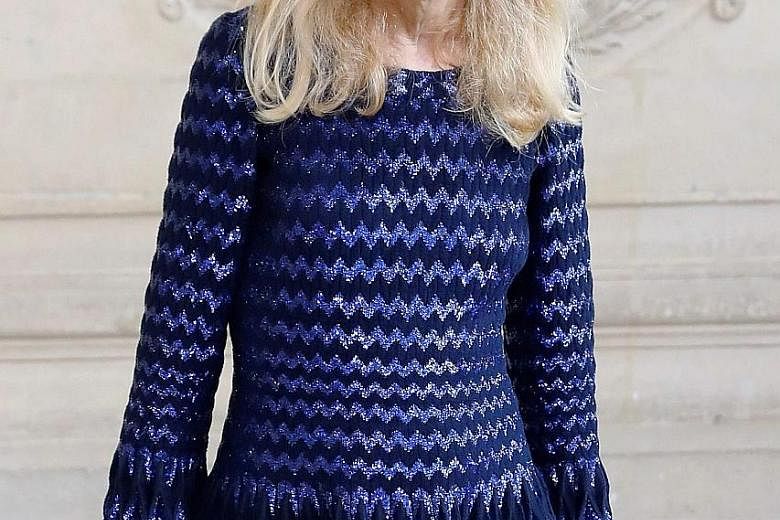NEW YORK • Franca Sozzani, under whose 28-year direction Italian Vogue reigned as a daring and often impious iconoclast on the newsstand, died on Thursday in Milan. She was 66.
Her death, after an unspecified year-long illness, was announced by Mr Jonathan Newhouse, the chairman and chief executive of Conde Nast International, which publishes Italian Vogue. In addition to being editor of that magazine, she had been, since 1994, the editorial director of Conde Nast Italy, under the Conde Nast International umbrella.
From her earliest days at Italian Vogue (and before that, at Lei and Per Lui, two discontinued but historic Italian fashion magazines), she nurtured the careers of who would become the most important fashion photographers of a generation, among them Peter Lindbergh, Paolo Roversi, Bruce Weber and, especially, Steven Meisel, who for many years photographed all its covers.
Photographers worshipped her for the unheard-of creative control she offered: She allowed them to choose their subjects and models, and frequently nudged against (or traipsed gaily beyond) the limits of convention or decorum.
"She had the best eye for photo- graphy," said Lindbergh, who began working with Sozzani in the early 1980s and kept up their collaboration for so long that she referred to herself as "the longest wife in your life". (They were not, in fact, married, though Lindbergh did say in a phone interview, only partly in jest, that he had been in love with her.)
"Italian Vogue was the most inspiring Vogue in the world," he added. "For over 25 years, Italian Vogue was ahead."
Born in Mantua, in the north of Italy, Sozzani found herself in fashion as if by accident.
After floundering in high style - she took a university degree in philosophy, entered into a brief marriage (annulled after three months) and made soul-searching visits to India and London - she returned to Italy and wound up an "assistant to the assistant to the assistant to the assistant" of Vogue Bambini, a children's clothing magazine.
She was named editor of Lei in 1980, of its men's counterpart, Per Lui, in 1982, and of Italian Vogue in 1988.
Though she was a beauty, with Pre-Raphaelite curls and a durable elegance immune to trends, she was not entirely seduced by the world of appearances in which she travelled. "Here's what I think: Fashion isn't really about clothes," she said in an interview in 2013. "It's about life."
Accordingly, her magazine never shied from the reality in which her readers lived. Her irreverence could border on the heretical. In one famous shoot by Meisel, on the theme of plastic surgery, she showed doctors hard at work on Linda Evangelista and a host of other models who were being injected, tucked and generally remodelled while blithely chatting away on their cellphones and then recovering at the St Regis.
But she addressed herself to serious concerns, too, dedicating photo shoots and special issues to themes too delicate for her international colleagues to touch: drug abuse and rehabilitation; domestic violence; and the Gulf oil spill of 2010.
Italian Vogue's "black" issue, in July 2008, when Americans were considering electing their first black president, was a controversial bestseller, featuring models of colour exclusively.
Sozzani's approach "gave Vogue a kind of power and surprise", Mr Newhouse said in an interview. There are two ways to make a magazine, he added. "One path is a conventional path," he said, "to fulfil what's expected, always give the readers and the advertisers what they want, and do it in the best way. That's a way that works.
"Another way is to break the mould and surprise and provoke and sometimes disturb your readers. That's a much harder way to do it and it's much harder to do well and Franca did it better than anybody."
Her fellow provocateurs applauded her for it.
"It's all about Italian Vogue," Madonna said in an interview with Aperture magazine in 1999. Or as Fabien Baron, the art director who worked for Sozzani at Italian Vogue, put it to Newsweek: "If Anna Wintour is the Steven Spielberg of fashion magazines, Franca is Pedro Almodovar."
Such risks did not endear her to every reader and Sozzani's choices - and her remarkably forthright blog on Italian Vogue's website - has raised hackles.
Some objected to her shepherding black models into a "special" issue and others disliked the oil-spill photographs.
She took special care to nurture emerging designers with Vogue's Who Is On Next? Prize.
"She was a godmother to talent everywhere," designer Diane von Furstenberg said in an interview.
Sozzani is survived by a son, Francesco Carrozzini.
A photographer and film-maker, he made a documentary about her, Franca: Chaos And Creation, which premiered at the Venice Film Festival in September.
NYTIMES

